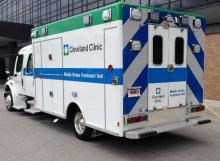WASHINGTON – A mobile stroke unit significantly reduced the time to evaluation, diagnosis, and treatment when compared with standard emergency medical units for patients experiencing symptoms of an acute stroke, Dr. Ken Uchino reported at the annual meeting of the American Academy of Neurology.
In a 1-year prospective study conducted in Cleveland, patients who were evaluated at the mobile stroke unit and diagnosed with an acute ischemic stroke received treatment with intravenous tissue plasminogen activator (TPA) a median of about 26 minutes earlier than did patients transported via EMS to the hospital’s stroke center, a statistically significant difference, said Dr. Uchino of the Cleveland Clinic’s cerebrovascular center and the Cleveland Pre-Hospital Acute Stroke Treatment (PHAST) study group.
In addition, 25% of the patients who were having an acute ischemic stroke received TPA within the first hour of the onset of symptoms, “the golden hour of thrombolysis.” No one in the control group met that goal, he noted.
American Heart Association/American Stroke Association guidelines recommend a door-to-needle time of 60 minutes or less and set a goal for participating hospitals to administer TPA to at least 50% of their patients with acute ischemic stroke within 60 minutes of arriving at the hospital.
Of the 100 patients evaluated for stroke, 33 had a probable acute ischemic stroke and 16 of 19 patients who qualified received intravenous TPA.* One patient did not receive TPA because of crew error, and there were problems with intravenous access in two patients. Another 30 were diagnosed with a possible acute ischemic stroke. Of the remainder, 4 were diagnosed with a transient ischemic attack, 5 were diagnosed with intracerebral hemorrhage, and 28 were classified as “other.”
One patient with an intracerebral hemorrhage, a 93-year-old woman on warfarin, was successfully treated with prothrombin complex concentrate for warfarin reversal before arriving at the hospital.
Further study is needed to obtain data on the outcomes and cost-effectiveness of the mobile stroke units, he said.
The mobile unit is a modified emergency response vehicle staffed by a nurse, paramedic, emergency medical technician, and a CT technologist. The unit has a mobile CT scanner and telemedicine equipment with point-of-care lab testing; a vascular neurologist and a neuroradiologist work remotely to evaluate patients and images. The protocol starts with the 911 call and activation of the emergency medical system. An algorithm is used to identify patients who might be having a stroke.
Once the mobile stroke unit reaches the patient, the team performs a CT scan and lab testing and the vascular neurologist interacts remotely with the patient and the unit’s personnel. If a diagnosis is confirmed, intravenous TPA is initiated and the patient is triaged to the appropriate hospital, Dr. Uchino explained.The study compared the times to treatment for patients experiencing acute stroke symptoms who were treated at the mobile stroke unit in the city (100 patients) with those presenting to Cleveland Clinic hospital emergency departments with a stroke alert called within 30 minutes of arrival to the hospital (53 patients), from Jan. 1, 2014, through December 2014. The mean age of patients was 63 years, about 56% were females. Intravenous thrombolysis was administered to 16 patients (16%) of those in the mobile stroke unit group and 12 (almost 23%) of those in the control group, which was not a significant difference.
The door-to-CT completion time was a median of 13 minutes (range, 9-21 minutes) in the mobile stroke unit group and 18 minutes (range, 12-26 minutes) among controls (P = .0026).
The door-to-CT read time was a median of 25 minutes in both groups. The door-to-international normalized ratio result time was a median of 13 minutes (range, 7-18) in the mobile stroke unit group and 44 minutes (range, 36-61) among controls, a significant difference (P < .001). The median time for door-to-video login was 11 minutes (range, 7-17) for the mobile stroke unit group and 20 minutes (range, 14-27) for controls.
The door-to-intravenous thrombolysis time was a median of 32 minutes (range, 24-47) in the mobile unit group and 58 minutes (range, 52-66) among controls, a 26-minute difference that was statistically significant, (P = .0012), Dr. Uchino said. The median time from the onset of symptoms to thrombolysis was 97 minutes (range, 61-144) in the mobile stroke unit group and 123 minutes (range, 110-176) in the controls (P = .0485).
Dr. Uchino and his associates at the Cleveland Clinic are part of the Cleveland PHAST study group; other participants include Case Western Reserve University. He had no disclosures. The mobile unit received funding from the Milton and Tamar Maltz Family Foundation and the Cleveland Clinic.


